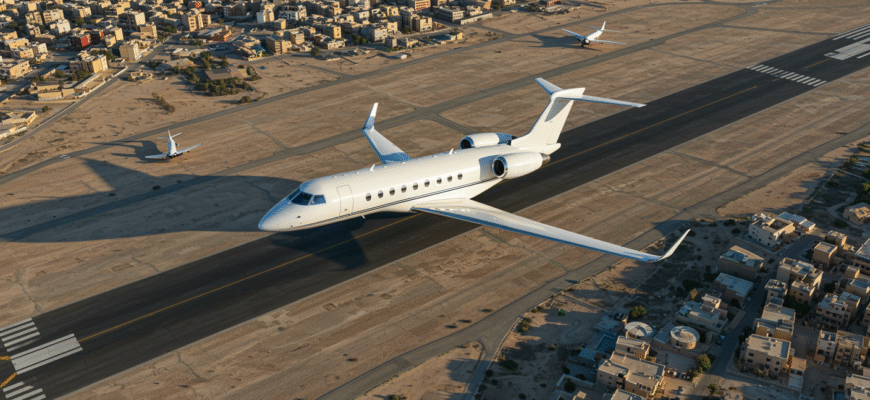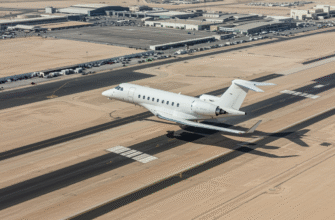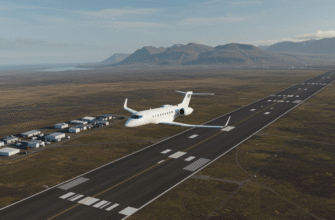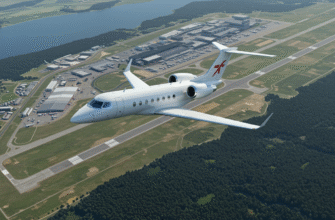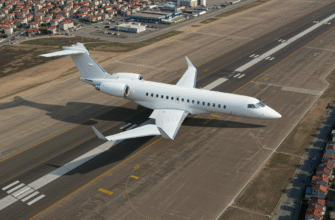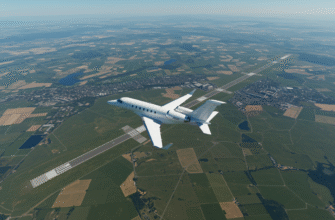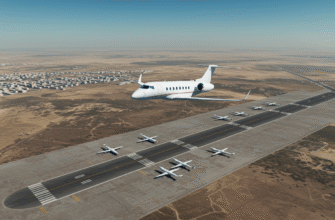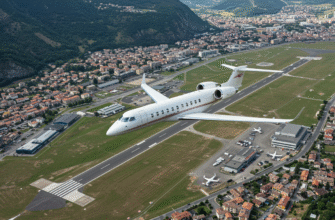Tucked just beyond the buzzing chaos of Amman’s city center, Amman-Marka Airport (ADJ) exists in a strange kind of limbo: officially operational, but quietly forgotten. It rarely shows up on travel forums or flight booking sites. Tourists fly right past it, gravitating toward the newer, sleeker Queen Alia International. And yet, hidden behind chain-link fences and “Restricted Entry” signs, Marka is very much alive. Not for casual travelers, but for the kind of traffic that doesn’t want to be noticed.
Unlike Queen Alia — Jordan’s polished international gateway — Marka operates in shadows. It’s where military convoys disappear through private hangars, and VIP travelers touch down without paparazzi or press. Private jets, military transports, chartered freighters — they all call ADJ home. It’s also where flight schools run hundreds of training hours day and night, and sensitive air cargo lifts quietly into the sky.
So, why care about a place that people pretend doesn’t exist? Because what happens here still matters. From strategic intel support to emergency routing during regional disruptions, Marka is more than a backup — it’s a chess piece in the geopolitical game. This post will trace its history, unpack its myths, and walk straight through the rumors that have haunted its runways for decades.
From Raf Outpost To Royal Air Stronghold
Marka didn’t start out as a mystery — it started out as the main event. Built by the British Royal Air Force in the 1950s, it once held the title of Jordan’s premier international airport. For over three decades, it served as Amman’s primary air gateway. International dignitaries flew in here. Diplomatic tensions played out over its tarmac. Real espionage and Cold War surveillance missions reportedly launched from within its hangars.
But when Queen Alia International opened in 1983, most commercial traffic jumped ship. Marka transitioned, but it didn’t bow out. It transformed into a nexus for military operations and discreet aviation business — arguably more powerful, just less public.
- Home base for the Royal Jordanian Air Force and training squadrons
- Frequent touch-and-go operations from U.S., NATO, and Gulf allied aircraft
- Still maintains robust customs infrastructure and a runway suitable for large cargo jets
It’s like the old house no one visits, yet the wiring still controls the whole block.
Talk Of Tunnels And What’s Not On The Map
People who’ve worked at Marka don’t always talk about it openly. But when they do, the stories are striking. Construction workers from the 1980s say there were sealed-off accessways under the airport — massive enough to move trucks through. Some believe they connected bunkers used during regional standoffs, possibly linking to old British intelligence storage or even diplomatic hideouts.
Retired engineers recall strange setups beneath the aircraft facilities — walls reinforced far beyond spec, ventilation systems with room-sized ducts, and unidentified passageways that disappeared after renovations. No blueprints with these features have been released publicly.
Are these just Cold War leftovers? Maybe. But they align too neatly with airport lockdown patterns and the occasional blackout of public radar feeds for certain incoming aircraft. Pilots joke about the “ghost taxiways” — painted routes that lead nowhere or into sealed-off zones.
Flights That Don’t Make The News
You won’t find Marka listed in your average flight tracker app, but that doesn’t mean it’s quiet. In fact, there’s a different kind of rhythm to its air traffic — one less visible but all the more deliberate.
| Aircraft Type | Purpose | Notable Behavior |
|---|---|---|
| Gulfstream G550 (Private Jets) | VIP transport, corporate figures, royalty | Often lands without public flight plan |
| Hercules C-130 | Military cargo and humanitarian aid | Multiple daily flights, nighttime ops favored |
| UN-marked aircraft | NGO personnel and sensitive mission support | Minimal ground exposure, heavily guarded offloading |
| Legacy Boeing cargo jets | Heavy engineering maintenance, covert cargo | Stay parked off-terminal for days |
Several planes arriving at ADJ aren’t listed on civilian radar. Insiders say it’s not a mistake. It’s intentional. Some aircraft fly under identifiers assigned only to defense or diplomatic flights. Others are scrubbed from online tracking altogether — by request.
Some footage still leaks. Jet-watchers in the area have caught glimpses of cloaked convoys unloading at odd hours. Local residents talk about cars parked overnight with windows blacked out and engines running. But official statements? None.
Amman-Marka Airport isn’t just a remnant. It’s alive — quiet, secretive, and still moving players across real-world battlefields. The next part will dig deeper into what happens here when the cameras are off and the lights go low.
Who’s flying into ADJ after dark
Officially, the arrivals are mostly charters, military, and training flights. Off the record? It gets murkier the later it gets. Amman-Marka Airport lights up after midnight in ways Queen Alia never does—not with tourists but with aircraft that won’t appear on any commercial flight tracker.
The visible traffic includes military crafts, medevacs, and sleek Gulfstreams with opaque windows. What you don’t see are the itineraries. Landings happen with no chatter on public airband frequencies. Some locals swear they’ve seen unmarked, foreign aircraft slip in and out with flashing lights cut off until final approach.
Intelligence community insiders whisper about “ghost shuttles”—smaller jets rumored to be carrying high-level personnel. These flights get priority clearance without questions. No press, no record, and more security on the ground than nearby embassies see on high alert days. If you’re flying in with a state secret or an alias, this is the runway for you.
Cargo without signatures
Big metal bodies land in the early morning hours. The kind that make the ground hum. Cargo containers are rolled out, forklifts race in under armed escort, and then… nothing. No paperwork, no customs interaction, and sometimes, no visible crew.
Former workers from Jordan International Air Cargo ramble off the record about wooden crates offloaded in silence. No barcodes, no invoices. Just wrapped and loaded directly into military trucks. “It’s like they weren’t even meant to exist,” one ex-contractor shared while lighting a cigarette outside the airport fence. “We didn’t ask. You just don’t.”
Speculation leans heavy on military equipment transfers—standard in a region charged with endless strategic tension. But a few describe stranger hauls: pallets labeled in languages they couldn’t read or boxes that made a low humming sound. Even the hardened forklifts guys kept their distance.
Civilian contractors and third-party silence
When the military wants discretion, private companies pick up the slack. Gun-for-hire firms and security logistics contractors pass through Marka like it’s a side entrance to a more complicated play. No uniforms, no insignias—just dark polos, tactical boots, and quick boarding onto turbo props with blacked-out tail numbers.
These “grey flights” come and go without media, press releases, or even airport announcements. Outsourced missions, plausible deniability, and a trail that ends at the tarmac. One source, a former flight crewmember, described moving “personnel that didn’t technically exist,” some with fake names and blank diplomatic passports.
It’s nothing new in post-9/11 geopolitical logistics where deniability is the name of the game. And ADJ plays that game well.
The tunnel theories
Go far enough back in the records, and you’ll find infrastructure plans from the 1960s that show more than just the runway and hangars. Older maps hint at underground storage or “rapid transit routes,” possibly designed in case of war. Post-Cold War redraws? Those zones often don’t appear.
The juicy part? Some engineers who worked at Marka claim that these tunnels weren’t demolished—just sealed. No demolition permits. No aerial view that shows change. Instead, rumors swirl of steel-reinforced access points hidden around the perimeter, now camouflaged by tarmac or weeds.
Supposedly, they connect to hardened bunkers beneath the nearby hills. Not verified, never public—just persistent murmurs. A former fuel operations manager once claimed, “If you stack two Hercules full of ammo underground, nobody needs to know what you’re doing up top.”
Urban legends or evidence?
Jordanian teens used to dare each other to sneak onto the outer fences of Marka in the early 2000s. Some swore they saw hidden doors in the hillside. Others claimed trucks went into hangars and never came out on the same side. It sounds like desert boogeyman stuff—until you start asking the night staff.
A night fuel clerk named Saleh said, “We sometimes see lights beneath the runway. Like someone turned on a hallway below.” No explanation was given, and questions often got shut down. That same year, requests for airport construction permits jumped dramatically—with several citing “emergency infrastructure repurposing.”
Old blueprints back that up: corridors marked “Classified Utility Access” with no descriptions attached. Official replies? Silence. Always silence.
Energy signatures and foreign interest
If you’re not looking at the satellite data, you’re missing half the story. Both Russian and U.S. intelligence satellites have been caught pinging thermal scans and energy emissions around ADJ. That wouldn’t be strange—until you realize they’re watching areas with no formal usage reports.
Weirder still: several European research teams have requested access to the Marka zone under “regional geology surveys” and “ground conductivity testing.” But locals on the ground reported seeing those scientists escorted by military personnel and never returning after that first ‘trip.’
Some high-altitude scans recently picked up spikes underground—heat patterns that resemble either large generator rooms or command-level bunkering. Whatever’s down there isn’t just old Cold War junk. It’s alive, temperature-stable, and drawing attention from people who don’t normally mess with dusty Jordanian airfields.
Marka’s not just another sidelined airport. It’s a magnet for secrets buried under years of classified concrete.
